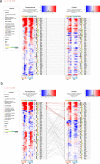multiSLIDE is a web server for exploring connected elements of biological pathways in multi-omics data
- PMID: 33863886
- PMCID: PMC8052434
- DOI: 10.1038/s41467-021-22650-x
multiSLIDE is a web server for exploring connected elements of biological pathways in multi-omics data
Abstract
Quantitative multi-omics data are difficult to interpret and visualize due to large volume of data, complexity among data features, and heterogeneity of information represented by different omics platforms. Here, we present multiSLIDE, a web-based interactive tool for the simultaneous visualization of interconnected molecular features in heatmaps of multi-omics data sets. multiSLIDE visualizes biologically connected molecular features by keyword search of pathways or genes, offering convenient functionalities to query, rearrange, filter, and cluster data on a web browser in real time. Various querying mechanisms make it adaptable to diverse omics types, and visualizations are customizable. We demonstrate the versatility of multiSLIDE through three examples, showcasing its applicability to a wide range of multi-omics data sets, by allowing users to visualize established links between molecules from different omics data, as well as incorporate custom inter-molecular relationship information into the visualization. Online and stand-alone versions of multiSLIDE are available at https://github.com/soumitag/multiSLIDE .
Conflict of interest statement
The authors declare no competing interests.
Figures




Similar articles
-
SLIDE - a web-based tool for interactive visualization of large-scale - omics data.Bioinformatics. 2019 Jan 15;35(2):346-348. doi: 10.1093/bioinformatics/bty534. Bioinformatics. 2019. PMID: 29955804 Free PMC article.
-
CRAMER: a lightweight, highly customizable web-based genome browser supporting multiple visualization instances.Bioinformatics. 2020 Jun 1;36(11):3556-3557. doi: 10.1093/bioinformatics/btaa146. Bioinformatics. 2020. PMID: 32108858
-
Panomicon: A web-based environment for interactive, visual analysis of multi-omics data.Heliyon. 2020 Aug 19;6(8):e04618. doi: 10.1016/j.heliyon.2020.e04618. eCollection 2020 Aug. Heliyon. 2020. PMID: 32904262 Free PMC article.
-
Network-Based Approaches for Multi-omics Integration.Methods Mol Biol. 2020;2104:469-487. doi: 10.1007/978-1-0716-0239-3_23. Methods Mol Biol. 2020. PMID: 31953831 Review.
-
Using MetaboAnalyst 4.0 for Metabolomics Data Analysis, Interpretation, and Integration with Other Omics Data.Methods Mol Biol. 2020;2104:337-360. doi: 10.1007/978-1-0716-0239-3_17. Methods Mol Biol. 2020. PMID: 31953825 Review.
Cited by
-
OmicsTIDE: interactive exploration of trends in multi-omics data.Bioinform Adv. 2023 Jan 20;3(1):vbac093. doi: 10.1093/bioadv/vbac093. eCollection 2023. Bioinform Adv. 2023. PMID: 36698763 Free PMC article.
-
An overview of technologies for MS-based proteomics-centric multi-omics.Expert Rev Proteomics. 2022 Mar;19(3):165-181. doi: 10.1080/14789450.2022.2070476. Epub 2022 May 2. Expert Rev Proteomics. 2022. PMID: 35466851 Free PMC article.
-
Introducing dysfunctional Protein-Protein Interactome (dfPPI) - A platform for systems-level protein-protein interaction (PPI) dysfunction investigation in disease.Curr Opin Struct Biol. 2024 Oct;88:102886. doi: 10.1016/j.sbi.2024.102886. Epub 2024 Jul 13. Curr Opin Struct Biol. 2024. PMID: 39003916 Review.
-
PaintOmics 4: new tools for the integrative analysis of multi-omics datasets supported by multiple pathway databases.Nucleic Acids Res. 2022 Jul 5;50(W1):W551-W559. doi: 10.1093/nar/gkac352. Nucleic Acids Res. 2022. PMID: 35609982 Free PMC article.
-
PerSEveML: A Web-Based Tool to Identify Persistent Biomarker Structure for Rare Events Using Integrative Machine Learning Approach.bioRxiv [Preprint]. 2023 Oct 30:2023.10.25.564000. doi: 10.1101/2023.10.25.564000. bioRxiv. 2023. Update in: Mol Omics. 2024 Jun 10;20(5):348-358. doi: 10.1039/d4mo00008k. PMID: 38196661 Free PMC article. Updated. Preprint.
References
Publication types
MeSH terms
LinkOut - more resources
Full Text Sources
Other Literature Sources

